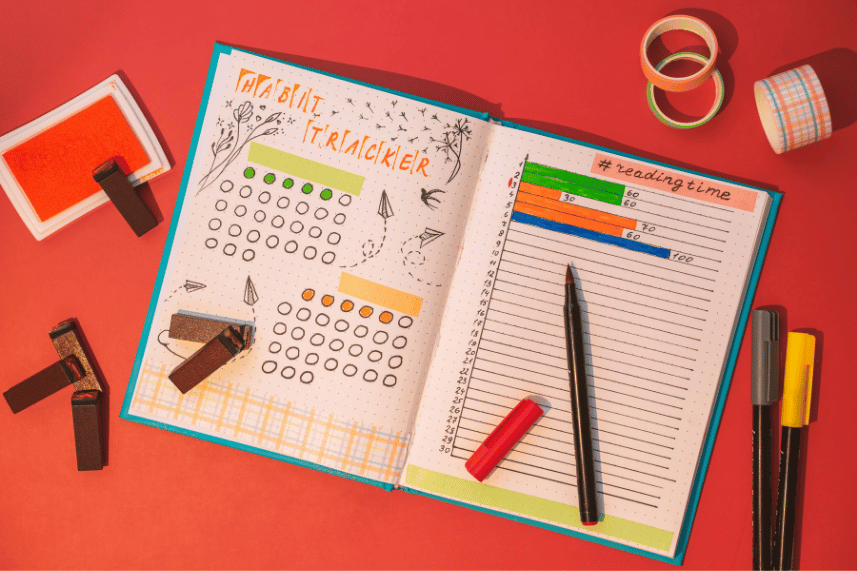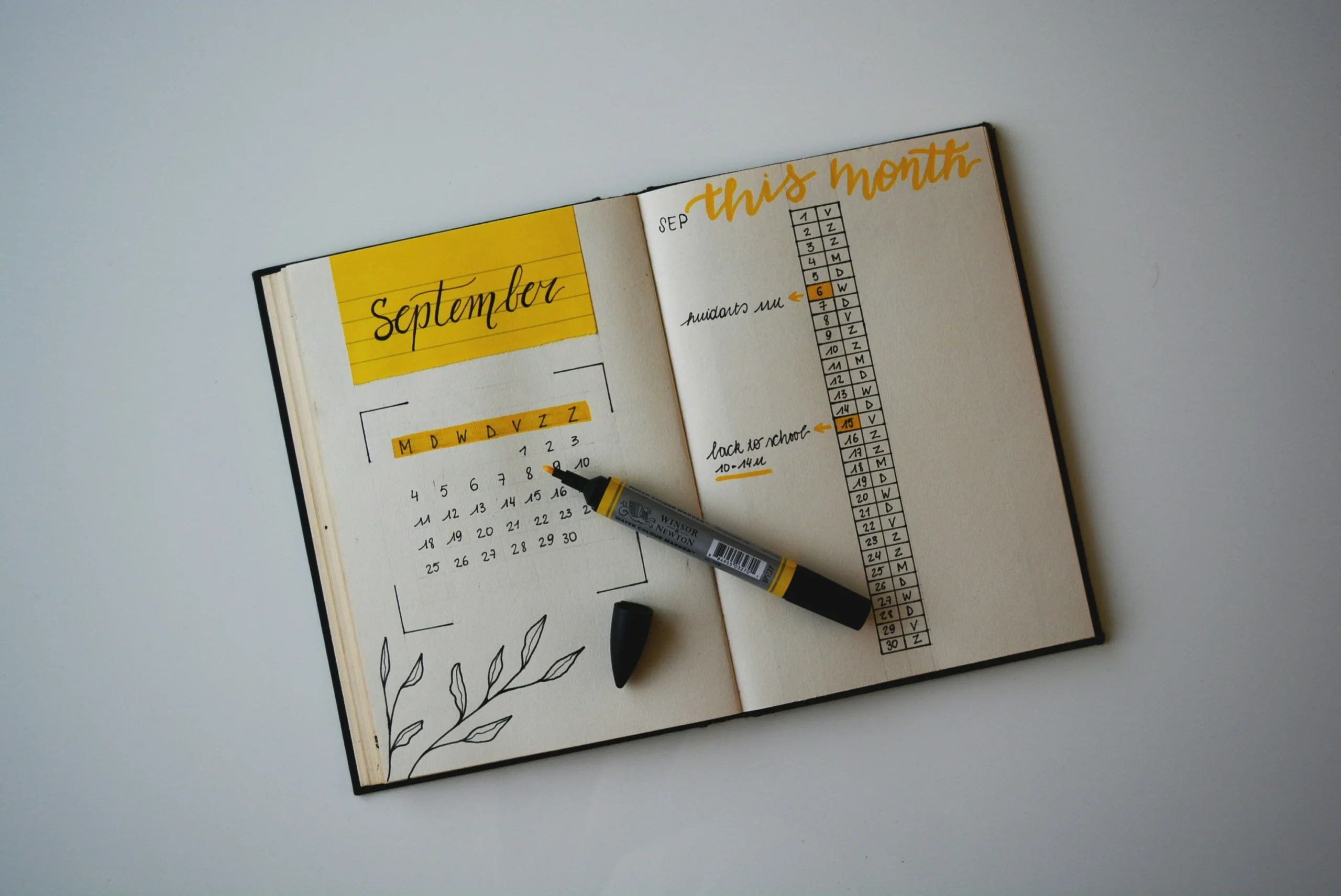If you’re looking for a way to organize your life, boost productivity, and express creativity, a bullet journal might be the perfect tool for you. Bullet journaling combines planning, note-taking, and journaling into one customizable system.
Your life is your story, and your bullet journal is the pen.
Anonymous
Here’s a detailed guide to help you get started:
What is a Bullet Journal?
A bullet journal is a flexible, analog system designed to track the past, organize the present, and plan for the future. Created by Ryder Carroll, it uses simple symbols and rapid logging to keep everything in one place, from to-do lists and calendars to goals and habit trackers.
Supplies You Need
- A Notebook: Choose one that suits your style and needs. Popular choices include dotted or grid notebooks like Leuchtturm1917 or Moleskine.
- Pens and Pencils: Use pens that don’t bleed through the paper. Fine liners, gel pens, and colored pens are great for adding variety and color.
- Ruler: For drawing straight lines and creating neat layouts.
- Optional Supplies: Washi tape, stickers, stencils, and highlighters for adding decorative elements.
| Page | Section | Description |
| 1-2 | Index | List of topics and their corresponding page numbers. |
| 3-4 | Future Log | Yearly overview with important dates and events for each month. |
| 5-6 | Monthly Log | Monthly calendar and task list for current month. |
| 7 | Daily Log | Daily entries for tasks, events, and notes. |
| 8-9 | Collection | Habit Tracker: Track daily habits like exercise, reading, and water intake. |
| 10 | Collection | Book List: List of books to read and their statuses (completed, in progress). |
| 11 | Collection | Meal Plan: Weekly meal planning and grocery list. |
| 12 | Daily Log | Daily entries for tasks, events, and notes. |
Basic Structure of a Bullet Journal
- Index:
- The first few pages serve as an index. It helps you quickly find specific sections or entries by logging page numbers and topics.
- Future Log:
- A yearly overview where you can jot down important dates, events, and future tasks. Divide the pages into months and note upcoming commitments.
- Monthly Log:
- A calendar spread for the month. Include a list of tasks, events, and goals you want to accomplish within the month.
- Daily Log:
- Day-by-day entries where you list tasks, events, and notes. This is the heart of the bullet journal, where you keep track of daily activities and to-dos.
- Collections:
- Custom pages for specific topics, such as habit trackers, book lists, meal plans, project notes, and more. Collections are a great way to organize information relevant to your interests and goals.
Example Entries
Index
| Topic | Page Number |
| Future Log | 3-4 |
| Monthly Log (July) | 5-6 |
| Habit Tracker | 8-9 |
| Book List | 10 |
| Meal Plan | 11 |
Future Log
| Month | Important Dates/Events |
| January | New Year’s Day (1st), Project Deadline (15th) |
| February | Valentine’s Day (14th), Dentist Appointment (20th) |
| March | Friend’s Wedding (8th), Conference (25th-27th) |
Monthly Log (July)
| Date | Task/Event |
| 1 | Pay Rent |
| 4 | Independence Day BBQ |
| 10 | Team Meeting |
| 15 | Doctor’s Appointment |
| 20 | Project Deadline |
| 25 | Start Vacation |
Daily Log
| Date | Task/Event/Note | Symbol |
| July 1st | Pay Rent | • |
| Team Meeting | ○ | |
| Buy Groceries | • | |
| Call Mom | • | |
| Great idea for the project: use a timeline visual | ! |
Key Symbols
- Tasks:
- Represented by a simple dot (•). When completed, you turn the dot into an X. If a task is migrated to another day, use an arrow (>) to indicate it’s been moved.
- Events:
- Denoted by an open circle (○). This helps you distinguish between tasks and scheduled activities.
- Notes:
- Marked with a dash (—). Use this for general information, observations, and non-actionable items.
- Priorities:
- Add a star (*) next to high-priority tasks or events.
- Ideas:
- Use an exclamation point (!) for inspiration or ideas you want to revisit.
Getting Started
- Set Up Your Index:
- Leave a few pages at the beginning for your index. Number the pages as you go and log the topics and page numbers here.
- Create Your Future Log:
- Divide a couple of pages into sections for each month of the year. Write down any important dates, events, or deadlines.
- Make Your Monthly Log:
- At the start of each month, create a calendar spread. List the month’s goals, important tasks, and events.
- Start Your Daily Log:
- Each day, create an entry for tasks, events, and notes. Use the key symbols to categorize and track them.
- Add Collections:
- As needed, create custom pages for specific interests or projects. These can be added anywhere in your journal and indexed for easy reference.
Habit Tracker
| Habit | 1 | 2 | 3 | 4 | 5 |
| Exercise | ✔ | ✔ | ✔ | ✔ | |
| Read 30 mins | ✔ | ✔ | ✔ | ||
| Drink 8 glasses | ✔ | ✔ | ✔ | ✔ | ✔ |
Book List
| Book Title | Author | Status |
| “The Power of Now” | Eckhart Tolle | Completed |
| “Mind Platter” | Najwa Zebian | In Progress |
| “Sell Like Crazy” | Sabri Suby | To Read |
| “Rich Dad Poor Dad” | Robert Kiyosaki | Completed |
Meal Plan (Week of July 5th)
| Day | Breakfast | Lunch | Dinner | Snacks |
| Monday | Oatmeal | Chicken Salad | Grilled Fish | Fruit |
| Tuesday | Smoothie | Turkey Sandwich | Spaghetti | Nuts |
| Wednesday | Eggs & Toast | Veggie Wrap | Stir-fry | Yogurt |
Tips for Success
- Keep it Simple:
- Start with the basics and add complexity as you become more comfortable with the system. Don’t overwhelm yourself with elaborate layouts at the beginning.
- Be Consistent:
- Make it a habit to update your journal daily. Consistency is key to making the most of your bullet journal.
- Customize to Fit Your Needs:
- The beauty of bullet journaling is its flexibility. Adapt the system to suit your lifestyle, preferences, and goals.
- Incorporate Creativity:
- Use colors, doodles, and decorations to make your journal visually appealing. This can also make the process more enjoyable and motivating.
- Review and Reflect:
- Regularly review your entries, reflect on your progress, and adjust your plans as needed. This helps you stay on track and achieve your goals.
Start Your Bullet Journal Now
Starting a bullet journal can be a transformative experience, helping you stay organized, focused, and creative. With a simple notebook and a few basic supplies, you can create a personalized system that keeps all aspects of your life in order. Give it a try and discover how this powerful tool can enhance your productivity and well-being.
Do you have any tips or experiences with bullet journaling? Share them in the comments below! If you found this guide helpful, share it with others interested in starting their bullet journal. Happy journaling!


















2 Comments
View Comments